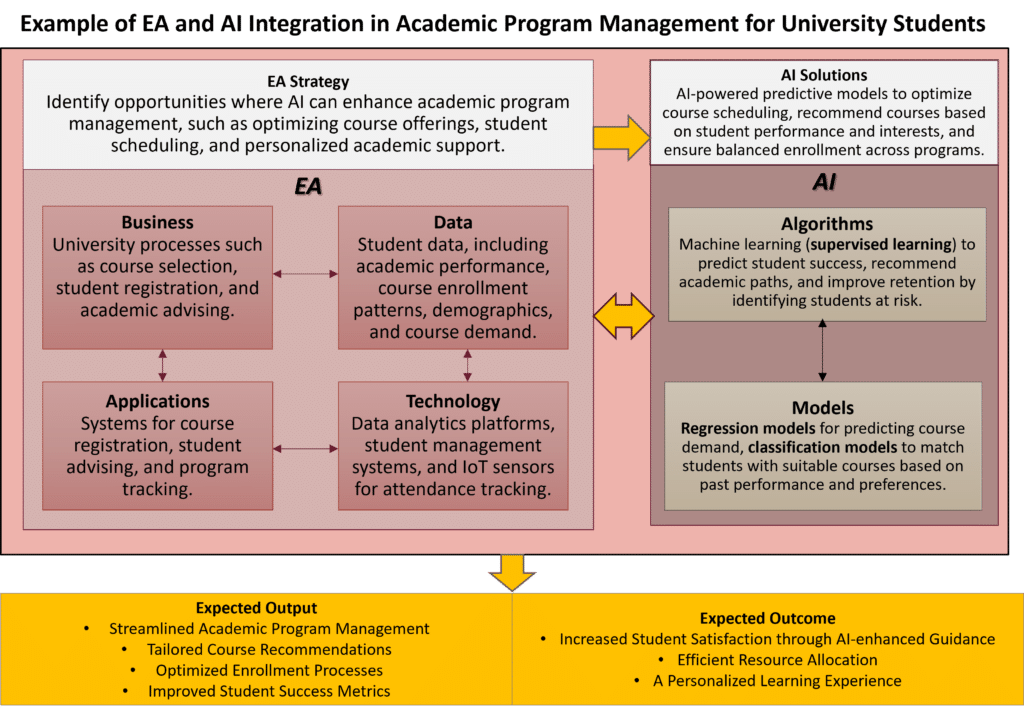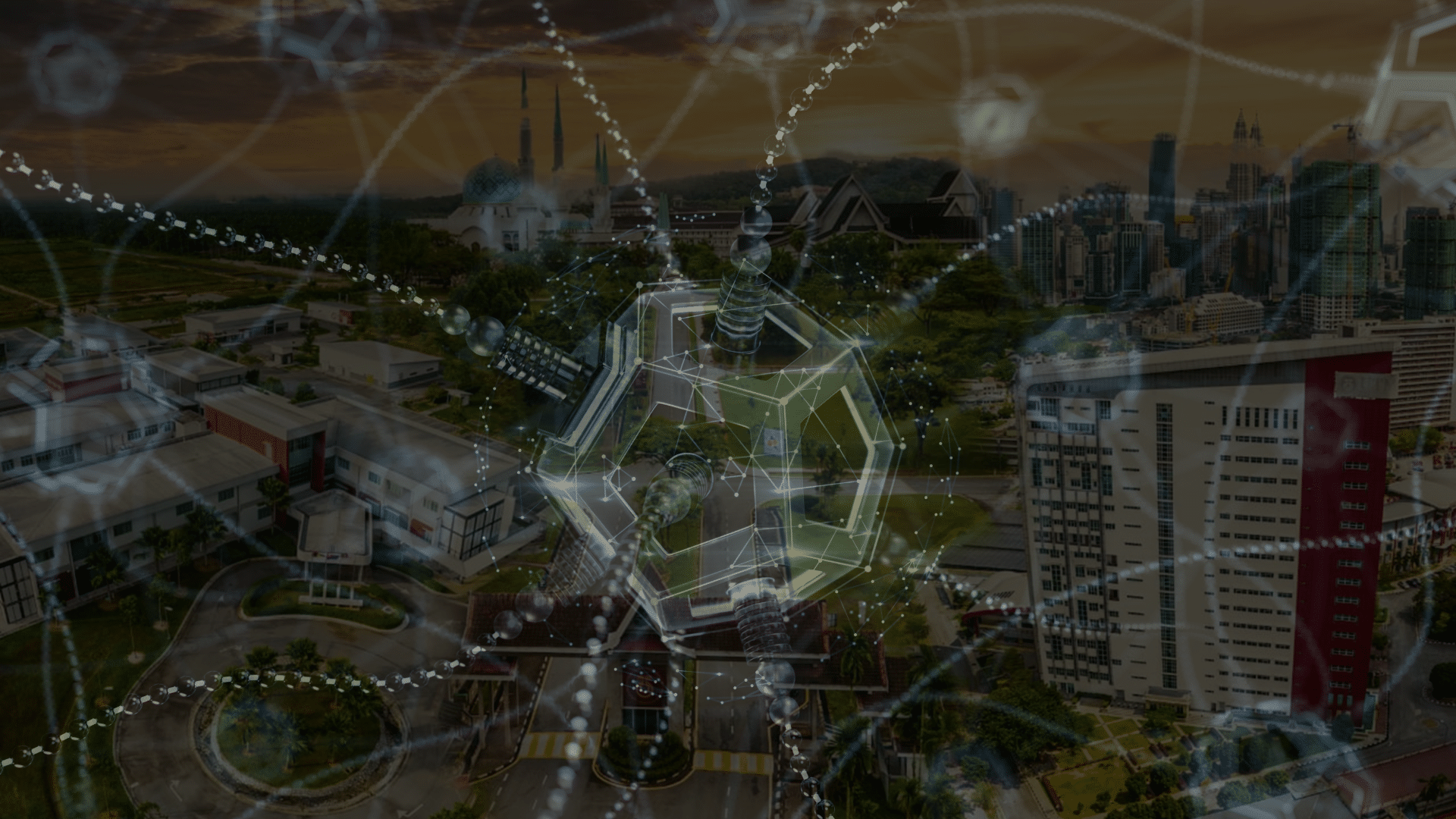Artificial Intelligence (AI) has become a transformative force in the digital era, reshaping how organisations align their business strategies with their information technology (IT) infrastructure. Integrating AI into Enterprise Architecture (EA) is a significant development, enabling organisations to optimise operations, innovate, and respond more effectively to an increasingly dynamic digital landscape. EA, a strategic framework that aligns processes, technology, and data with organisational goals, becomes even more powerful when enhanced by AI. This integration offers a more agile, data-driven, and dynamic approach to managing organisational resources and operations.
The role of AI in digital transformation is becoming increasingly prominent, particularly in sectors such as higher education and the public sector. By incorporating AI into EA, organisations can streamline operations, foster more significant innovation, and improve decision-making capabilities. The infusion of AI enhances business architecture, data management, applications, and technology frameworks, making these systems more efficient, predictive, and responsive to change. As AI continues to evolve, its potential to revolutionise organisational operations and decision-making processes grows exponentially.
The Evolution of Enterprise Architecture (EA)
Enterprise Architecture (EA) has existed since the 1980s to manage IT systems and align them with business strategies. One of the earliest and most significant frameworks to formalise EA was the Zachman Framework, introduced by John Zachman in 1987. This framework provided a structured method for organising and understanding various aspects of an enterprise, including business processes, data, applications, and technology. It was a step towards a holistic view of an organisation’s IT infrastructure, helping businesses optimise their operations and align technology with organisational goals.
In the 1990s, The Open Group Architecture Framework (TOGAF) was introduced, which became one of the most widely adopted EA frameworks. TOGAF offered a methodology to design, plan, implement, and manage EA, ensuring business strategies aligned with IT infrastructure. Over the years, frameworks such as the Federal Enterprise Architecture Framework (FEAF) and Department of Defense Architecture Framework (DoDAF) were developed to address the unique needs of government and defence sectors, respectively, further demonstrating the versatility of EA across different sectors.
The Role of AI in Enhancing Enterprise Architecture
Integrating AI within EA marks a transformative shift in how organisations manage their digital ecosystems. AI enhances decision-making by analysing extensive datasets, forecasting trends, and optimising resource distribution. Through predictive analytics, AI identifies emerging patterns, automates processes, and refines decision-making, driving operational efficiency and adaptability. By leveraging AI, organisations can streamline business processes and ensure their strategies are data-driven, enabling them to remain competitive in a rapidly evolving landscape.
In data architecture, AI significantly elevates an organisation’s ability to process and extract insights from vast amounts of information. With machine learning (ML) and natural language processing (NLP), organisations can uncover hidden patterns in unstructured data, enhancing decision-making and strategic planning. Furthermore, AI optimises application and technology architecture, improving system integration and automating workflows. This synergy between AI and EA provides organisations with heightened agility, enabling them to adapt swiftly to shifting market dynamics and foster a culture of innovation, unlocking new growth opportunities while maintaining operational excellence.
AI-Enabled Digital Transformation in Higher Education and the Public Sector
Integrating AI into EA is a pivotal enabler of digital transformation in both the public sector and higher education. In the public sector, AI automates processes, enhances predictive analytics, and optimises decision-making across various government functions. AI-driven solutions enable authorities to forecast traffic patterns, refine urban planning, optimise energy usage, and improve public safety measures, fostering the development of smarter, sustainable cities. These advancements propel the digital economy, enhancing government services to be more efficient and responsive to societal needs while paving the way for agile governance and intelligent policy-making.
In higher education, AI reshapes the academic experience by personalising learning, automating assessments, providing real-time feedback, and streamlining research management. AI also supports academic innovation by offering predictive insights that guide research, optimise resource allocation, and enhance academic data management. As demand for AI-driven solutions grows, higher education institutions embrace AI to improve engagement and academic performance and foster a culture of innovation. The widespread adoption of AI in both sectors highlights the critical role of AI and EA frameworks in driving long-term growth, optimising operations, and delivering value for stakeholders.

AI and MyGovEA in Malaysia’s Public Sector
In Malaysia, the recent convergence of EA and AI is driving the digital transformation of the public sector. The MyGovEA Framework, introduced in 2017, provides a strategic structure for aligning public sector information and communication technology (ICT) initiatives with national priorities. Facilitating coordination across government agencies optimises service delivery and enhances operational efficiency, establishing a unified approach to governance. As part of the Pelan Strategik Pendigitalan Sektor Awam 2021-2025, Malaysia has prioritised the integration of AI into EA frameworks to accelerate its digital agenda, positioning AI as a catalyst for innovation and progress.
The infusion of AI within the MyGovEA Framework amplifies its capabilities, enabling government agencies to automate processes, forecast emerging trends, and make data-driven decisions. This AI-driven shift cultivates a more agile, responsive public sector that is better equipped to address the challenges of the digital economy. AI-enabled EA facilitates proactive governance by optimising resource allocation and enhancing decision-making, aligning with Malaysia’s vision of becoming a leading digital economy. Technology’s central role in public service delivery underscores the nation’s commitment to a more efficient, intelligent, and future-ready public sector.
AI in Higher Education: UTM’s Vision for Digital Transformation
Universiti Teknologi Malaysia (UTM) has long recognised the strategic importance of integrated technological frameworks and advanced digital solutions in driving institutional innovation, academic excellence, and operational efficiency. Through its ongoing strategic planning, embodied in initiatives like enVision 2025 and the Moonshot Transformative Journey, UTM has consistently aligned its academic, research, and administrative functions with modern technological infrastructures. This alignment reflects the integration of EA and AI, ensuring that these advanced frameworks underpin UTM’s broader strategic goals. The seamless incorporation of these digital solutions is now becoming standard practice, ensuring that innovative, data-driven approaches are embedded into all aspects of the institution’s operations.
With Malaysia’s first Faculty of AI launch in 2024, UTM is reinforcing its leadership in digital integration, not just in Malaysia but globally. The university’s Pelan Strategik Pendigitalan UTM 2024-2028 outlines the transition from strategic vision to operational reality, with EA and AI playing a central role in shaping UTM’s digital future. UTM’s commitment to embedding these advanced technological practices into its infrastructure and daily operations fosters a culture of continuous innovation. This proactive implementation ensures the university’s readiness for the evolving landscape of education, technology, and research, allowing UTM to stay at the forefront of technological advancements and shape the future of higher education in Malaysia and beyond.
Addressing Security, Privacy, and Ethics in AI-Enabled EA
As AI becomes more integral to EA, it introduces critical security, privacy, and ethics concerns. Deploying AI-driven systems demands robust cybersecurity frameworks to guard against data breaches, cyberattacks, and algorithmic vulnerabilities. Additionally, AI applications must adhere to stringent privacy regulations, such as the General Data Protection Regulation (GDPR), ensuring that sensitive data is protected and user trust is preserved. These safeguards are essential to maintaining the integrity and security of AI systems within organisations.
The ethical implications of AI are equally pressing. AI systems must be transparent, accountable, and devoid of biases that could perpetuate discrimination or inequality, particularly in healthcare, education, and public safety. Organisations must implement governance frameworks that ensure responsible AI deployment, safeguard individual rights and promote fairness. In Malaysia, the government is actively addressing these challenges by developing comprehensive AI governance frameworks and ethical standards. These initiatives guarantee that AI is deployed securely, ethically, and responsibly, fostering the digital transformation of the public sector and higher education while protecting citizens and maintaining public trust.
The Future of AI-Enabled Enterprise Architecture in Malaysia
AI-enabled EA is transforming both the public sector and higher education, unlocking unprecedented opportunities to innovate, streamline operations, and enhance decision-making. By seamlessly integrating AI with EA, institutions can optimise processes, foster continuous innovation, and improve service delivery. This strategic convergence drives immediate efficiencies and positions organisations for long-term, sustainable growth and competitive advantage. Furthermore, integrating AI enhances organisations’ ability to adapt to rapidly changing environments, enabling them to stay ahead of the curve in an increasingly complex digital landscape.
AI adoption within EA frameworks in Malaysia is critical in the nation’s digital transformation. Government initiatives such as the MyGovEA Framework and the Pelan Strategik Pendigitalan Sektor Awam provide a robust foundation for AI integration across public sector operations, ensuring enhanced coherence, efficiency, and responsiveness in service delivery. Similarly, higher education institutions like UTM are driving AI adoption by optimising resources, improving student engagement, and advancing research excellence. As Malaysia pursues to become a digital economy, AI-enabled EA will be central to creating a more agile, innovative, and data-driven public sector and educational system. This commitment to AI integration will ensure sustainable growth, elevate service delivery standards, and position Malaysia as a global leader in digital innovation, empowering both government and institutions to make smarter, data-driven decisions that will shape the nation’s future for decades.
About the Author
Associate Professor Ts. Dr. Nur Azaliah Abu Bakar is from the Faculty of Artificial Intelligence (FAI) and serves as the Associate Director of UTM International Kuala Lumpur. She specialises in Enterprise Architecture (EA) and digital transformation. With over a decade of experience, she has contributed to significant national and international projects, including those with the Ministry of Rural and Regional Development (KKDW), the Ministry of Education (MOE), PlanMalaysia, the International Islamic University Malaysia (IIUM), and the Institut Teknologi Kalimantan (ITK). Her work focuses on EA and ICT Strategic Planning to drive digital innovation and advance AI-driven solutions.

